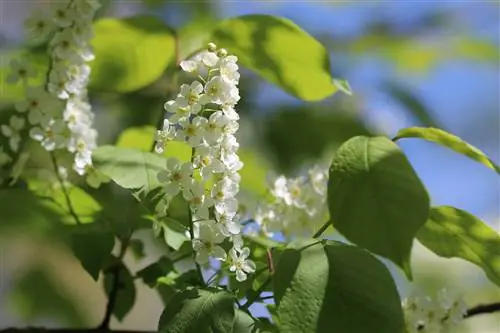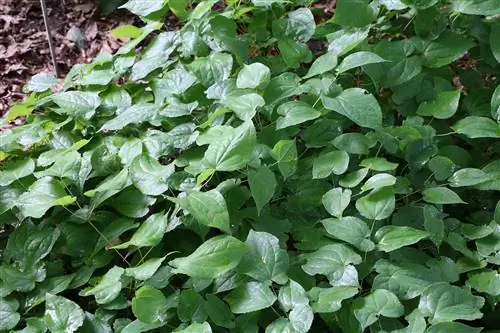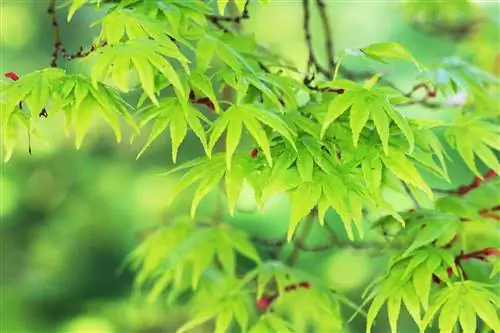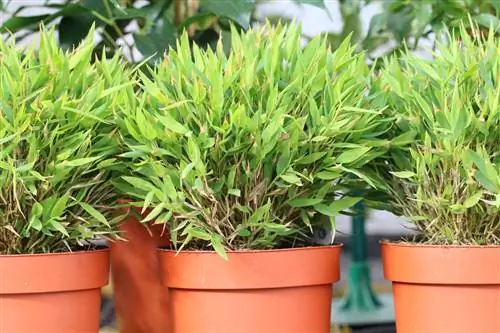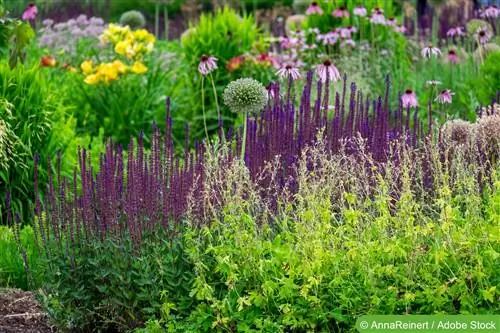- Author admin [email protected].
- Public 2023-12-17 03:39.
- Last modified 2025-01-24 12:45.
The daylily can count a large number of flowers per season and can bloom for up to six weeks. They not only impress with their magnificent flower colors, but also with their different flower shapes.
Profile
- Family: Daylily family (Hemerocallidaceae)
- Botanical name: Hemerocallis
- German name: Daylily
- Growth: herbaceous, perennial, often in clumps
- Growth height: depending on the variety 20-100 cm
- Foliage: elongated, linear, evergreen to evergreen
- Flowers: funnel-shaped, star-shaped, one or two colors, fragrant
- Flowering time: June until well into August
- Toxicity: not poisonous
- Lime compatibility: lime tolerant
Location requirements
With sufficient soil moisture, daylilies thrive in both full sun and partial shade, although flower production is lower in partial shade. The sunnier the location, the more flowers, with the exception of some red and dark purple varieties, they are sometimes sensitive to direct sun and intense rainfall. Light shading and a sheltered spot can help here.
Soil texture
These plants generally thrive in any normal garden soil. They feel comfortable in loamy, heavy, but also sandy and not too dry substrates. The best results are achieved in slightly nutrient-rich, loose and humus-rich soil as well as soil enriched with compost. What the daylily doesn't like are waterlogged, compacted or dry soils and hot, sterile sandy soils.
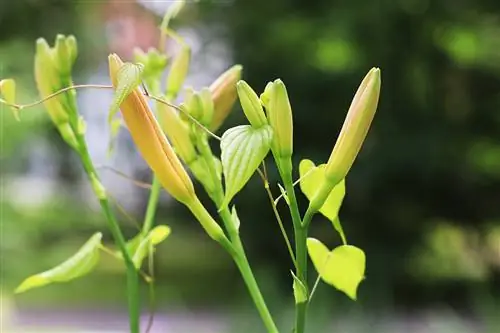
Best planting time
Daylilies (Hemerocallis) can be planted in spring and autumn on frost-free days depending on the root packaging. While bare root crops should be planted immediately after purchase, container plants can be planted all year round. If you stick to the planting times, the lilies can grow and develop well until the onset of winter. Planting in spring also has the advantage that the plants will still bloom in the same year they are planted.
Planting in the bed
Before planting, bare-root plants should be watered thoroughly. In the meantime, dig sufficiently large planting holes at appropriate intervals.
- Planting holes approx. 30 cm deep
- Distances between 40-50 cm
- Enrich excavated soil with compost
- Loosen the soil in the planting pit well
- create a small mound of earth in the middle
- put the plants on it
- Spread roots to all sides
- Root base one to two centimeters below the surface of the earth
- fill with excavated earth, press down the earth, pour in
- Mulch layer recommended
Tip:
It is important not to plant the daylilies too deep, otherwise flowering could be delayed.
Planting in a bucket
- Small-flowered Hemerocallis hybrids are particularly suitable
- Soil volume of the planter from seven liters
- Equip the floor with drainage
- fill in part of the substrate
- Insert daylily in the middle
- maintain sufficient distance from several plants
- fill with substrate, press soil and water
Tip:
If the pot becomes too small over time, it is time to repot, but at the latest after three years. The old soil and damaged or rotten parts of the roots are removed.
Pouring
The soil in which the daylilies grow should be neither too dry nor too moist. Prolonged drought would cause flower buds to fall off. Dryness also has an impact on the size of the flowers.
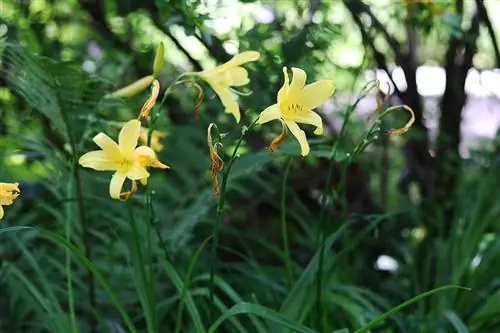
- therefore pay attention to even soil moisture
- additional watering during the main growing season from April to May.
- Water regularly even in persistent drought and heat
- short dry periods no problem
- do not water the plants
- otherwise there is a risk of fungal infestation
- Mulch layer keeps moisture in the soil longer
Tip:
Specimens in pots require more water due to the smaller soil volume and should be watered daily, especially in summer.
Fertilize
Similar to watering, daylilies (Hemerocallis) require additional fertilizer during the main growth phase in April/May. Since these perennials can stand in the same place for up to 20 years, annual fertilization is essential.
- Add some compost in the spring, usually sufficient
- long-term fertilizer recommended on poor or nutrient-poor soils
- Nutrient requirements higher on sandy soils poor in nutrients and humus
- lower on clayey substrates
- also suitable for flowering plant fertilizer, manure and plant manure
- or apply a layer of bark mulch
- Provide the soil with nitrogen beforehand
Freshly planted specimens should not be fertilized for the first time until eight weeks after planting, provided that compost has already been incorporated during planting. Commercially available liquid fertilizer in the appropriate dosage is suitable for daylilies in pots.
Cutting
Wilted flowers should be removed regularly so as not to weaken the plant and prevent the formation of seeds. In summer, all clumps with wilted or yellow leaves can be cut off. New leaves will appear again within a few days. A cut close to the ground is recommended both in autumn and in spring. Cutting in autumn reduces the risk of fungal infection, but deprives the plant of good winter protection in the form of old, dead foliage. On the other hand, if you cut in spring, the frost protection is retained, but there is a risk of fungal infestation.
Wintering
There are a lot of things you can do over the winter to ensure that the daylily continues to thrive.

In the bed
When overwintering, you have to differentiate between herbaceous, evergreen and semi-evergreen varieties. Daylilies that grow over the winter survive the cold season best. They can usually withstand temperatures of up to minus 30 degrees and do not require any protection. The situation is somewhat different with varieties that retain all or part of their leaves; they must be protected accordingly. This can be done by covering it with brushwood, leaves, bark or other insulating materials.
In the pot
Daylilies in pots need winter protection. In autumn you cut off the withered leaves. Place the pot in a protected place, on a wooden pallet or Styrofoam. It is wrapped with fleece or similar materials. Now it is important to ensure that the substrate never completely dries out over the winter.
Propagate
There are various options for propagating daylilies:
Division
Dividing perennials is the most common and effective form of propagation and is also ideal for rejuvenating older, senile plants. A lack of space or a decline in flower production despite fertilization are also good reasons to divide a plant. In contrast to sowing, division creates daughter plants that are identical to the mother plant.
- best time in spring or autumn
- Carefully dig out complete clumps
- free from coarse soil
- then rinse the roots with a garden hose
- divide with hands or a sharp knife
- Short the leaves and roots a little
- Plant sections separately from each other
- Press soil and water
- Watering more afterwards
Tip:
Rejuvenation is recommended every two to three years, but at the latest after three to five years. This prevents aging and maintains growth and flowering.
Sowing
This method of propagation requires a lot of patience. Seeds for sowing can be obtained from the seed capsules of existing plants or from specialist garden shops. They are ripe about six to eight weeks after flowering.
- stratify immediately after harvest
- store in the refrigerator over the winter
- Sow at the end of February / beginning of March
- Soak seeds in water for two or three days beforehand
- Fill the cultivation container with cultivation soil
- Spread seeds on top
- cover about seed thickness with substrate
- Moisten the substrate and keep it evenly moist
- Germination time between three days and a month
- optimal germination temperature at 20 degrees
- plant outside after the Ice Saints
Axillary shoots / Kindel
In addition to division, propagation by kindling (pro-delivery) also produces plants that are identical to the mother plant. They develop approximately in the middle of the flower stalks and usually already have tiny roots in late summer.
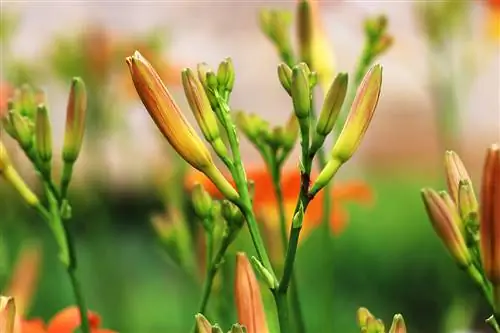
- Do not separate the child from the stem
- leave part of the stem on the axillary shoot
- Separate the stem approx. six centimeters underneath
- fill small pots with potting soil
- Insert the childel including the handle
- Press soil and water
- Leave pots with children outside until late autumn
- bring it into the house before the first frost
- overwinter in a frost-free, cool and bright place
- harden off the plants in spring
- initially only out during the day and by the hour
- to a protected place
- Transplant into the bed in mid-May at the earliest
Tip:
Not every daylily produces these axillary shoots.
Fungal infections
In some cases, fungal infections such as tuber rot can occur. A corresponding infestation can be recognized by a stalled and yellowing shoot. The leaves have a soft to mushy consistency and are easy to pull off the stems. To save the plant, it must be dug up and anything rotten cut off or removed. You should cut into he althy tissue. The lily can then be replanted, preferably at an angle so that water can drain away from the crown. In most cases, however, affected plants can no longer be saved and must be disposed of.
Snails
Even if the daylily is not one of the preferred foods of snails, young plants as well as new shoots and flowers are particularly at risk. To protect the plants, you can collect the snails regularly or use organic snail pellets.
Hemerocallis gall midge
Among the pests worth mentioning is the gall midge. Individual buds are attacked, the substance of which is permanently damaged and they die. The first signs of an infestation are misshapen, swollen buds that release a brownish liquid when touched. You should hurry up. Early varieties are particularly susceptible. This pest is of little importance during the main flowering period.


